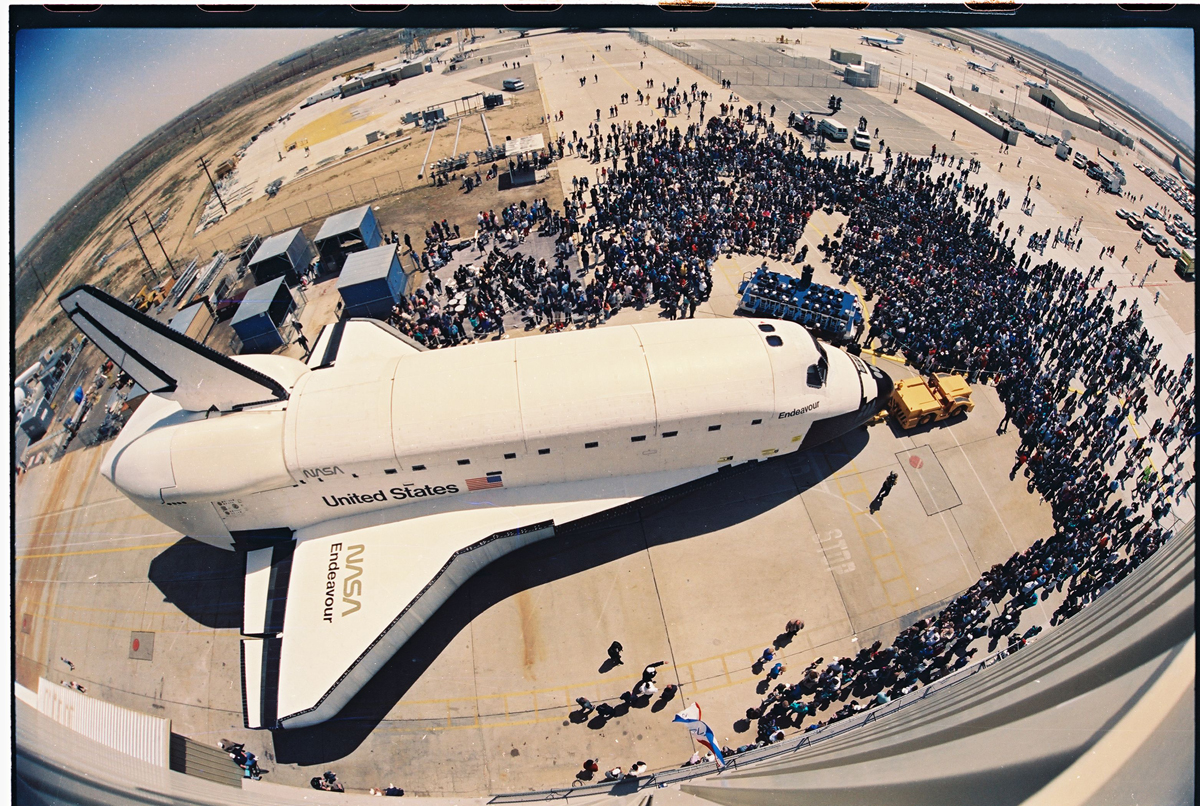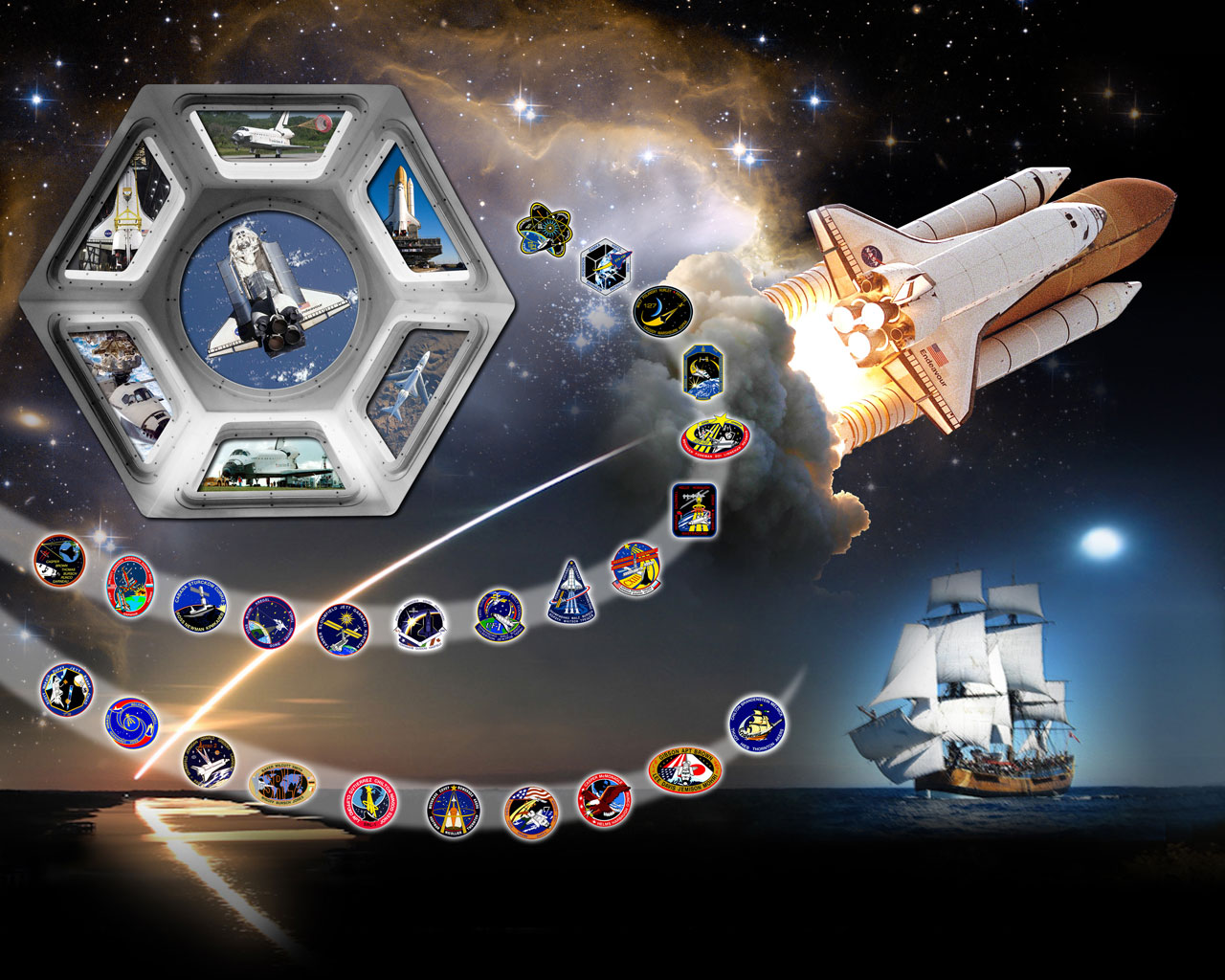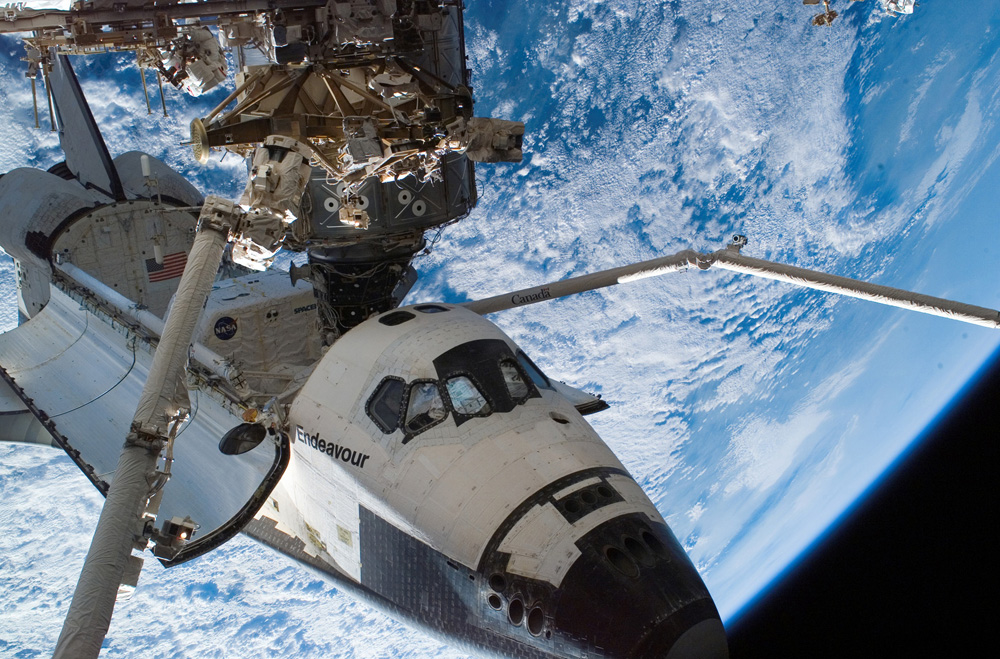NASA's Youngest Shuttle: The Historic Endeavors of Space Shuttle Endeavour

Twenty years after exiting its assembly facility for its maiden mission, space shuttle Endeavour is poised on the launch pad to fly its final flight.
NASA's youngest orbiter, born from a tragedy, Endeavour made its debut on April 25, 1991, as it was rolled out from Rockwell's construction hangar in Palmdale, Calif. The fifth and last of the U.S. space agency's reusable winged spacecraft to enter the shuttle fleet, Endeavour arrived at the Kennedy Space Center in Florida a month later.
In the two decades since, Endeavour has left its mark on history, saving the Hubble Space Telescope, giving birth to the International Space Station (ISS), and completing a mission begun by the fallen shuttle it was built to replace. It also launched the first African-American woman and the first married couple. [Most Memorable Space Shuttle Missions]
Now it is set to fly one last mission to the ISS to deliver a state-of-the-art experiment, a crowning achievement for an accomplished spacecraft.
"Since Endeavour's first flight to this flight, it's had a really outstanding career," said Capt. Mark Kelly, commander of Endeavour's final mission, after arriving April 27 in Florida for the orbiter's last launch.
"We are going to take Endeavour out for a couple more, probably about five or six million more miles. It's already got about 110 [million] miles on it. After 25 flights, we will hopefully land here [at Kennedy Space Center] and then Endeavour is done with its service to the country," added Kelly.
Kelly and his five STS-134 crew members are scheduled to launch onboard Endeavour at 3:47 p.m. EDT (1947 GMT) on Friday, April 29 for a two-week mission.
Get the Space.com Newsletter
Breaking space news, the latest updates on rocket launches, skywatching events and more!
"It hasn't been around as long as [orbiters] Discovery and Atlantis, but it has done some pretty major things," Kelly said about Endeavour during an earlier NASA interview.
Challenger's successor sets sail
Endeavour inherited its legacy from NASA's second-to-fly orbiter, which tragically was lost 73 seconds into its 10th launch in January 1986.
"Endeavour was the replacement for Challenger," Kelly recounted. "After the Challenger accident, Congress appropriated money to build [a replacement]."
Initially NASA considered retrofitting its prototype orbiter to take Challenger's place.
"At the time the thought was, well, maybe we could modify Enterprise, which was the approach and landing test orbiter," said Kelly. "It was decided that to build a new one would actually be more cost-effective to do, build a brand new orbiter, and that became Endeavour."
Largely assembled from spare parts pre-fabricated during the development of Discovery and Atlantis, NASA's fifth orbiter, or OV-105, was completed in 1991. All that it still needed was a name. [Gallery: Building Space Shuttle Endeavour]

"There was a little contest that decided how we're going to name it," recalled Kelly.
Endeavour was christened through a contest initiated by Congress in response to the concern by students over the loss of Challenger. NASA opened the competition with the provision the proposals were drawn from nautical tradition.
The NASA Orbiter-Naming Project received 6,154 entries, representing more than 70,000 students. The winner was announced by President George H.W. Bush in May 1989.
Endeavour's name was inspired by the 18th century sailing ship assigned to chart the South Pacific under British explorer Capt. James Cook's command. His Endeavour was small at about 368 tons, 100 feet in length and 20 feet wide. In contrast, its modern day namesake is 78 tons, 122 feet in length and 78 feet wide.
"Top of the heap"
Endeavour launched on its inaugural mission, STS-49, on May 7, 1992, a year to the day after being delivered to the Kennedy Space Center. [Endeavour's STS-134 Flight Day Journal]
The nine-day flight quickly caught the world's attention. Tasked with salvaging the Intelsat-VI communications satellite, which had been launched into a uselessly low altitude orbit two years earlier, Endeavour's crew found the satellite impossible to grab with the tools they had been provided.
The solution, as first devised by the crew, demonstrated that three heads — or rather six hands — were better than two.
Endeavour's astronauts grabbed the satellite out of orbit during a one-of-a-kind three person spacewalk with Pierre Thuot, Rick Hieb and Tom Akers positioned as a human tripod in the shuttle's payload bay.
Once recovered, the astronauts equipped Intelsat with a new upper stage motor so it could resume its mission in time to support the live broadcast from the 1992 Summer Olympics.
"It was really a fun mission, once we knew the ending," said Dan Brandenstein, Endeavour's first commander and United Space Alliance executive vice president and chief operating officer, in a statement released by the company. "There were times there during the middle when I wasn't sure we were having much fun."
The crew's satellite-saving ad-lib would have been made much more difficult, if not impossible, were it not for the stable platform provided by NASA's newest orbiter.
"[Endeavour] was amazing. It came out of the factory, we launched and we didn't have a hiccup at all," Brandenstein recalled. "She's at the top of the heap, no doubt about it."
As Brandenstein piloted Endeavour to its first landing on May 16, 1992, a billowing drag chute was released from the orbiter's tail, among the most visible safety upgrades added to the shuttle fleet in response to Challenger's loss. Along with the improved steering and braking systems soon to also adorn Columbia, Discovery and Atlantis, the upgrades made it possible for the shuttles to begin routine landings in Florida.

Endeavour's many endeavors
When Endeavour next flew, launching on STS-47 on Sept. 12, 1992, the spacecraft displayed its range, providing a stage for several cultural milestones during an eight-day mission featuring Japanese science experiments. The shuttle's seven-astronaut crew included the first female African-American astronaut, Dr. Mae Jemison, as well as the first married astronauts, Mark Lee and Jan Davis.
A year later, Endeavour thundered into the spotlight again flying its fifth mission. Lifting off in late 1993, Endeavour's STS-61 crew raced to rendezvous with the Hubble Space Telescope. Hubble's highly anticipated orbital deployment on April 25, 1990 — coincidentally one year to the day before Endeavour's California reveal — was followed by the discovery that the orbiting observatory's primary mirror had a small but significant flaw.
During the 11-day STS-61 mission, the crew carried out a then-record five spacewalks to install corrective optics and new science instruments. [Photos: Shuttle Endeavour's Last Mission, STS-134]
Within weeks of Endeavour landing, Hubble embarked on a succession of stunning and still unfolding discoveries that have helped to confirm the existence of black holes, refine the age of the universe and reveal star- and planet-forming processes.
Endeavour lifted off again on Dec. 4, 1998 on STS-88, its 13th mission and the first of the shuttle's space station assembly missions. Over the 11-day flight led by Robert Cabana, currently the director of Kennedy Space Center, six astronauts joined the first U.S. and Russian pieces of the budding orbital laboratory, Unity and Zarya.
On subsequent missions, Endeavour lifted components of the station's solar power system, Japan's Kibo science module, supplies, research gear and astronauts assigned to live and work aboard the ISS.
On Endeavour's 20th flight, it picked up the torch first lit by one of Challenger's fallen crew. Endeavour's STS-118 astronauts included Barbara Morgan, a former elementary school teacher who previously served as the backup to Challenger's Christa McAuliffe. Morgan rejoined the space agency in 1998 and trained as an astronaut, drawing the opportunity to fly on Challenger's successor on a mission that added to the station's backbone truss.
STS-118 was also a return to flight for Endeavour, which had undergone a 24-month extensive upgrade, including installation of a glass cockpit and a power transfer system that enabled electricity to be siphoned from the station to extend the orbiter's stay in space.
Mission complete
Endeavour's STS-118 return to orbit was commanded by Scott Kelly. It will now fall to his twin brother, Mark, to return Endeavour from space one last time.
STS-134, Endeavour's 25th and final flight, will deliver and equip the station with the Alpha Magnetic Spectrometer (AMS), a $2 billion external astronomical experiment. The 14-day mission will also perform the first test flight of an autonomous rendezvous system developed for NASA's new generation crew vehicle, which will carry astronauts on future missions beyond low Earth orbit.
Perhaps more significantly, Endeavour's final mission will complete construction of the ISS, an activity it began just over 12 years ago.
"When the space shuttle was designed, it was designed to build the space station," said Mark Kelly. "Early on, the plan was you're going to build this space truck that could bring all this stuff up onto orbit [and] also to be able to service satellites in space. But, it was really designed to build the space station."
"So, when we attach the AMS on the outside of the space station truss, that's going to be assembly complete and [Endeavour] will have completed what it was built to do," said Kelly.
Follow space shuttle Endeavour’s final mission by visiting collectSPACE’s STS-134 Flight Day Journal.
You can follow collectSPACE on Twitter @collectSPACE and editor Robert Pearlman @robertpearlman. Copyright 2011 collectSPACE.com. All rights reserved.
Join our Space Forums to keep talking space on the latest missions, night sky and more! And if you have a news tip, correction or comment, let us know at: community@space.com.

Robert Pearlman is a space historian, journalist and the founder and editor of collectSPACE.com, a daily news publication and community devoted to space history with a particular focus on how and where space exploration intersects with pop culture. Pearlman is also a contributing writer for Space.com and co-author of "Space Stations: The Art, Science, and Reality of Working in Space” published by Smithsonian Books in 2018.In 2009, he was inducted into the U.S. Space Camp Hall of Fame in Huntsville, Alabama. In 2021, he was honored by the American Astronautical Society with the Ordway Award for Sustained Excellence in Spaceflight History. In 2023, the National Space Club Florida Committee recognized Pearlman with the Kolcum News and Communications Award for excellence in telling the space story along the Space Coast and throughout the world.










